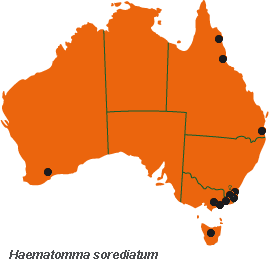



Australian Biological Resources Study
| Checklist of the Lichens of Australia and its Island Territories | ||
| Introduction | A–D | E–O | P–R | S–Z | Oceanic Islands | References | ||
| Haematomma sorediatum R.W.Rogers | ||
| Lichenologist 14: 124 (1982). T: Lakes Entrance, Vic., on bark of Notelaea ovata, Mar. 1889, F.R.M.Wilson s.n.; holo: MEL, n.v. | ||
| Thallus white to cream-coloured, yellow-grey, pale grey or greenish grey, smooth to rugulose and weakly warty, ±rimose to areolate, to 0.4 mm thick, corticate, sorediate. Soralia often ±globose, 0.5–2.0 mm wide, rarely diffuse, but then the thallus with irregular sorediate areas. Apothecia sessile, constricted at the base, 0.5–2.0 mm diam., not confluent; disc orange-red to cinnabar-red, with or without pale golden pruina; thalline margin prominent, smooth to weakly crenulate; in older apothecia the disc becoming undulate and the margin sorediate. Ascospores fusiform, straight or slightly curved, 9–19-septate, 45–70 × 4–6 µm. Conidia bacilliform, 7–8 × 0.8–1.0 µm. CHEMISTRY: Thallus K+ yellow, C–, KC–, Pd+ yellow; disc K+ violet; containing atranorin, haematommone (minor) and placodiolic acid (minor or trace). |  |
|
| Scattered in humid forests of south-western W.A., eastern Qld, N.S.W., Vic. and Tas.; grows on bark of Acacia, Notelaea, Pomaderris etc. This warm-temperate to tropical species also occurs in South America, southern Europe, Madeira and India. | ||
| Elix (2004c) | ||
| Checklist Index |
| Introduction | A–D | E–O | P–R | S–Z | Oceanic Islands | References |
This work is copyright. Apart from any use as permitted under the Copyright Act 1968, no part may be reproduced by any process without prior written permission from Australian Biological Resources Study. Requests and inquiries concerning reproduction and rights should be addressed in the first instance to Dr P. McCarthy. These pages may not be displayed on, or downloaded to, any other server without the express permission of ABRS.